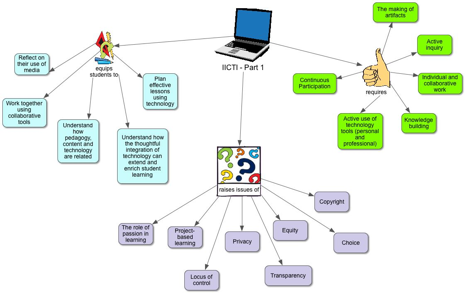 I’ve begun teaching an Additional Qualifications course for inservice teachers, about the integration of technology into their classroom practice. I’ve written about this new learning journey before, and I began revising and rethinking the course as soon as it got rolling the first time around. This is what I miss most about being a classroom teacher — the creative process involved in shaping learning environments that work!
I’ve begun teaching an Additional Qualifications course for inservice teachers, about the integration of technology into their classroom practice. I’ve written about this new learning journey before, and I began revising and rethinking the course as soon as it got rolling the first time around. This is what I miss most about being a classroom teacher — the creative process involved in shaping learning environments that work!
In planning courses we continue to find that many of the resources we turn to for guidance are often traditional, text-based models of learning, especially in higher education. This doesn’t often sit right with me. My goal is to help teachers imagine new possibilities in their own classrooms as they begin to shift their practice.
In setting out to model some more innovative practices, I hope that by seeing a variety of options as learners first, teachers will understand the power of these new approaches and feel free to play with some of these new tools and then reflect on them with a critical eye. Most of the teachers who will join me in these courses are newly connected to social networks, and therefore my aim is to plan a meaningful experience that is not too overwhelming.
These newly connected educators often look for some advice about where to jump in: Twitter? Blogs? Facebook? Social networks for teachers? There are so many choices! As a result, I’ve surfaced some thoughts about the difference between the work I do with networks and communities and how I might advise teachers who are newly connected.
Virtual colleagues? Business as usual
In an earlier blog post I was asking this question:
“I’m gravitating towards more collaborative work that involves a different kind of connection than something like twitter — what should I be recommending to others just starting down this path?”
I’ve been thinking about where I’m finding my best support for my own learning these days. While I’ve been going to my twitter network and saving links, resources, and graphics to help me plan this course, I’ve found that it’s actually my community of inquiry within Powerful Learning Practice that has lead me to the deepest learning along this new journey. Only a handful of these people are actually in the realm of my f2f connections and none of them are people I see day-to-day. Working virtually with people from my online community is just becoming business as usual!
As I begin teaching this course, I think I owe it to my learners to help them understand that while twitter networks might lead them to incredible contacts and resources, our classroom community will be where they can get down and dirty with some really messy learning.
Let me share a recent example. I was extremely lucky to be taking Sheryl Nussbaum-Beach’s PLP e-course Teaching Online: Becoming a Connected Educator back while I was building the first rendition of my own course curriculum. It gave me a source of feedback and critical friends when I was first drafting, asking questions, and pondering my next moves. Even now, 6 months after the PLP e-course, I am still in contact with several of those folks who I know would help me with revisions. This potential for an extended conversation about my work would not often happen on twitter, and actually I don’t know that it’s ever happened to me in a f2f context, either!
A great discovery
Next, something Sheryl recently posted in the PLP Community Hub caught my eye. It was a document that Howard Rheingold had shared, inviting folks to work on collaboratively transforming a course about social media for high school students. I had been cocooning a bit, thinking through my plans, and while following some of Howard’s links I discovered — a visual syllabus!
This was great. I already had the very (19th century) text-based one I’d created from the traditional University model I had been given as an exemplar. And I had the video version that I had made for my students as a course introduction for the first week. However, the ‘good’ thing about video is also the ‘bad’ thing about video…you have to watch it! You can’t scan it well. So a graphic organizer was just the thing I needed to turn the syllabus into more of an infographic. I got busy creating and came up with a first draft:
I posted this to my community inside the PLP Ning space, where Howard’s course outline is also posted, knowing that I would likely get some feedback, suggestions, and perhaps even a discussion wherein more folks share what they are doing in this area – and then BINGO – we’d be building collective knowledge.
Sure enough, the sharing began to happen almost immediately. Suzie Nestico posted a reply that caused me to think more deeply about some of the requirements that will need to be in place before my students will be able to understand the difference between “knowledge sharing” and “knowledge building.” This will help direct some of my next steps in planning.
While I learn lots and connect well with Twitter and my other networks, it’s my community of inquiry (both f2f and online) that helps me to dive deeper, which is where I like to be!
Brenda Sherry
Latest posts by Brenda Sherry (see all)
- PBL Experts Are All Around Us! - February 8, 2013
- Diving Deeply: Networks or Communities? - April 13, 2012



Brenda:
I’ve been reflecting on this lately, as I’ve been thinking about the New York Times article John Norton referenced in an e-mail earlier this week. The author really suggests that we are connected electronically to the detriment of our ability to connect with our face-to-face peers. I’m pretty sure that while I agree with some of her thoughts, I don’t agree with dismissing the connections we make in our online communities, and I think it is community that is the important word.
I have benefited immensely from your knowledge, and that of others this year on my PLP journey – I know that if I have questions, I can ask those people, and they will take my questions seriously, and answer them to the best of their abilities (which are pretty impressive). If I’m lost, I have some way-finders to hold my hand. I am the wayfinder for most people in the physical space where I teach, and it is so important for me to be able to go to my mentors (very few of whom I get to see in person) and say “help!” (and know that no-one will make me feel stupid – that’s been a big gift,and one I have take much learning from).
Ravelry was my first exposure to an on-line community that was different from anywhere else I’d been, and I was able to find a few forums that felt like home. I have friends there – friends I may never meet in physical form, but who send me hugs, and advice and even care packages. We exchange ideas on a deep level and are deepening the connections between us. It helped seed the ground for my experience with PLP.
A long-winded way to say – “yes, you need to find your way beyond Twitter”. Thanks for being an important and wonderfully welcoming part of my community!
Lisa,
Like you, I am constantly grateful and in awe of the generosity of the educators I meet online. After hearing Sherry Turkle (the person to whom John refers) at the Learning and the Brain Conference, I began to read her book Alone Together and to take a more conscious, mindful, or observant approach to my connections.
I’m thinking lately that it’s critical that we understand not only the benefits of being super-connected but also the drawbacks, or the cautions, and deal with them accordingly. Just as I can’t spend all my time chatting with colleagues at work or else I don’t get to other important things, so it is online.
As educators I think we also have some responsibility to share with students some of the effects of lots of different things (e.g. sleep, nutrition, exercise, drugs and also technology) on the brain. It just makes sense.
Thanks for your comment!
Brenda